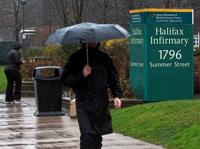HALIFAX - Nova Scotia's health unions say long-standing staffing shortages in emergency rooms are a key reason two hospital managers last week warned that some patients may be "dying" from long wait times.
Hugh Gillis, vice-president of the Nova Scotia Government and General Employees Union, says he was disturbed to learn how severe wait times have become in the province's ERs, to the point where surgeries were being cancelled and patients shifted to temporary locations.
He was reacting to a recent email to staff by managers at the Dartmouth General Hospital who said people were "dying" as a result of long periods waiting in hospital ER rooms. Nova Scotia Health has clarified the deaths weren't occurring in the waiting rooms themselves.
"It was shocking to see Nova Scotia Health admit how bad the crisis in our emergency departments has gotten, but this is the reality that front-line health-care workers are dealing with," Gillis said in an email.
He said the Department of Health and the main Nova Scotia health authority have long known that a staffing crisis was coming and have not done enough to retain emergency room staff.
Gillis said the union is hosting meetings with workers who "have ideas for what can be done to make things better," adding, "it’s well past the time that we listened to them."
Janet Hazelton, president of the Nova Scotia Nurses' Union, said the problem is partly due to COVID-19, a surge in influenza cases and to other respiratory illnesses, but she says labour shortages are something that could have been dealt with before the latest surge.
She said unions have been calling for years for more recruitment and retention measures, adding that a bonus program hasn't proved sufficient to retain ER nurses.
"We kept saying, 'If you don't address this, we're going to be in a crisis,' and it never was addressed by multiple governments," Hazelton said.
Hazelton said there are emergency departments where nurses haven't had a vacation day accepted in five months, and they also find they are frequently the focus of growing frustration from patients who have waited 10 to 14 hours for care.
She says it's possible the strong language in the Dartmouth General managers' email is being driven by fears that Nova Scotia's ERs will follow the pattern in New Brunswick, where two people are reported to have recently died in hospital waiting areas.
"If you have 30 or 40 patients waiting, you can't expect a single triage nurse to both initially assess and keep an eye on those people," she said. "They could deteriorate quickly. and someone ought to be responsible for checking on the waiting room."
Nova Scotia Health Minister Michelle Thompson declined an interview, referring Ďă¸ŰÁůşĎ˛ĘąŇĹĆ×ĘÁĎ to health authorities.
Dr. Mary-Lynn Watson, interim site lead for the Queen Elizabeth II ER in Halifax, said the underlying problem is the entire health system in the province is operating over capacity, and as a result more patients are occupying beds in ERs.
While surgeries are being delayed, and pop-up primary care clinics are being set up as a way of coping with shortages of family doctors, these measures haven't been enough to cope with the surge in patients.
Watson said one of the short-term measures being taken is to hire more ER staff on a temporary basis to do triage. "The Halifax Infirmary has added extra staff to help support the nurses who do triage," Watson said. "So there are extra staff assigned to check vital signs to ensure they're not becoming more ill."
However, she said the stark reality is that some patients who require immediate nursing assessment and rapid treatment are waiting "many hours."
Dr. David Kelvin, a Dalhousie University researcher and the research chair of vaccinology, said in an email that what's occurring in Nova Scotia's ERs stems from a number of factors.
"It is in a way a perfect storm: influenza, RSV (respiratory syncytial virus), Omicron BA5, holiday parties, family get-togethers, and Christmas and New Year's approaching," he wrote. He recommended that everyone get a COVID-19 vaccine booster as well as a flu shot, with a high dose for people over 65.
This report by Ďă¸ŰÁůşĎ˛ĘąŇĹĆ×ĘÁĎ was first published Dec. 12, 2022.








































